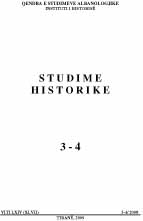Institucionet qeverisëse të komunës së Shkodrës (gjysma e parë e shek. XIV)
The governing institutions of the commune of Shkodra (the fist half of 14th century)
Author(s): Ermal H. BazeSubject(s): History
Published by: Qendra e Studimeve Albanologjike
Keywords: governing institutions ; commune of Shkodra ; 14th century ; Albania; Albanian History;
Summary/Abstract: The statuaries of Shkodra during the early decades of the 14th century yield important data on the development and the institutional organisation of the urban commune of Shkodra in the middle ages. The statuaries should have been in two copies to which all the local inhabitants were obliged to act upon as well as the foreigners entering the city. The sovereign rights on the city of Shkodra during this period belonged to the Serbian monarchy, the authority of which was represented by the earl, an important political figure that respected the communal selfadminstation. Another important governmental body of the commune of Shkodra was the citizens’ assembly that was summoned on the day of Saint Mark on the 25th of April in the presence of the bishop and the local nobility during which would be selected three judges, eight counsellors and the two financiers of the city. All of them formed the Commune’s Council and the mandate for the governing of the city was for one year. The College of the Judges and the Commune’s Council comprised the government of the city were all the decisions would be approved and implemented with consensus and a majority of votes. In all the pyramidal structure of the commune’s governing of Shkodra, the judges played an important role. Parallel to the governing institutions of the commune, were the symbols of the civic sovereignty part of which were the seal and the measuring units and the weights. All these governmental institutions testify that the city of Shkodra situated between East and West was aiming to integrate and follow the rhythm of the time that during this period was oriented toward the northern part of the western Adriatic.
Journal: Studime Historike
- Issue Year: 2008
- Issue No: 03-04
- Page Range: 019-038
- Page Count: 20
- Language: Albanian
- Content File-PDF

